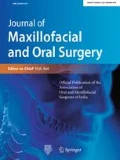Abstract
Objective
To evaluate the clinical outcomes of alternative techniques of intubation in patients sustaining maxillofacial injuries, where nasotracheal intubation (NTI) is best avoided.
Material and Methods
Alternative techniques to standard naso-tracheal intubation like submental intubation, orotracheal intubation-retrotuberosity/retromolar and missing dentition were used and variables of clinical outcome recorded.
Results
Submental intubation provides an unobstructed intraoral surgical field, avoids intraoperative and postoperative complications of tracheostomy, and overcomes the disadvantages of NTI. In our experience with submental intubation (6 cases), we only had complication related to tube apparatus like damage to pilot balloon. With retrotuberosity intubation (5 cases) we did not encounter any complications and the only limitations were bulbous maxillary tuberosity. Retromolar intubation (4 cases) a safe noninvasive technique has disadvantages like tube interference within the surgical field and not feasible in case of limited retromolar space. Orotracheal-missing dentition intubation (4 cases) is of great advantage i.e. it can be used in cases where NTI is contraindicated, no specialized skill required, no added cost, avoids the need for tracheostomy, no extra-oral procedures required and does not interfere with occlusion/MMF; with disadvantage of occasional tube interference within the surgical field.
Conclusion
Preferred techniques of securing an airway like orotracheal, nasotracheal may not always be applicable, thus a trauma surgeon-anesthesist team should always have alternative techniques in their armamentarium to reduce the morbidity associated with these patients without interference with occlusion, which is prime goal in jaw fracture reduction. We have used these techniques in a country with limited resources and found them equally effective and convenient to use.





Similar content being viewed by others
References
Hall CEH, Shutt LE (2003) Nasotracheal intubation for head and neck surgery. J Anesth 58:249–256
Meyer C, Valfrey J, Kjartansdottir T, Wilk A, Barierre P (2003) Indication for and technical refinements of submental intubation in oral and maxillofacial surgery. J Craniomaxillofac Surg 31:383–388
Taher AA (1992) Nasotracheal intubation in patients with facial fractures. Plast Reconstr Surg 90:1119–1120
Marlow TJ, Goltra DD, Schabel SI (1997) Intracranial placement of a nasotracheal tube after facial fracture: a rare complication. J Emerg Med 15:187–191
Bernard AC, Kenady DE (1999) Conventional surgical tracheostomy as the preferred method of airway management. J Oral Maxillofac Surg 57:310–315
Hafez A, Couraud L, Velly JF, Bruneteau A (1984) Late cataclysmic hemorrhage from the innominate artery after tracheostomy. J Thorac Cardiovasc Surg 35:315–319
Tuzuner-Oncul AM, Kucukyavuz Z (2008) Prevalence and prediction of difficult intubation in maxillofacial surgery patients. J Oral Maxillofac Surg 66:1652–1658
Crosby ET, Lui A (1990) The adult cervical spine: implications for airway management. Can J Anaesth 37:77–93
Telford RJ, Liban JB (1991) Awake fibreoptic intubation. Br J Hosp Med 46:182–184
Delaney KA, Hessler R (1988) Emergency flexible fiberoptic nasotracheal intubation: a report of 60 cases. Ann Emerg Med 17:919–926
Agro F, Hung OR, Cataldo R, Carassiti M, Gherardi S (2001) Lightwand intubation using the trachlight: a brief review of current knowledge. Can J Anaesth 48:592–599
Dong Y, Li G, Wu W, Su R, Shao Y (2013) Lightwand-guided nasotracheal intubation in oromaxillofacial surgery patients with anticipated difficult airways: a comparison with blind nasal intubation. Int J Oral Maxillofac Surg 42(9):1049–1053
Altemir FH, Montero SH, Hernández Montero S, Hernández Montero E, Moros Peña M (2004) Hazards of submental tracheal intubation. Anaesthesia 59(1):140
Jundt JS, Cattano D, Hagberg CA, Wilson JW (2012) Submental intubation: a literature review. Int J Oral Maxillofac Surg 41:46–54
Ramsey CA, Dhaliwal SS (2010) Retrograde and submental intubation. Atlas Oral Maxillofacial Surg Clin N Am 18:61–68
Lazaridis et al (2012) Retrotuberosity versus submentosubmandibular and median submental intubation: patients with maxillofacial surgery. Oral Surg Oral Med Oral Pathol Oral Radiol 114(suppl 5):S209–S215
Vidya B, Cariappa KM, Kamath AT (2012) Current perspectives in intra operative airway management in maxillofacial trauma. J Maxillofac Oral Surg 11(2):138–143
Lieger O, Zix J, Kruse A, lizuaka T (2009) Dental injuries in association with facial fractures. J Oral Maxillofac Surg 57(8):4–1660
Acknowledgements
The authors thank all the faculty and residents from departments of Oral and Maxillofacial Surgery and Anaesthesiology and Critical Care.
Conflict of interest
None.
Author information
Authors and Affiliations
Corresponding author
Rights and permissions
About this article
Cite this article
Jaisani, M.R., Pradhan, L., Bhattarai, B. et al. Intubation Techniques: Preferences of Maxillofacial Trauma Surgeons. J. Maxillofac. Oral Surg. 14, 501–505 (2015). https://doi.org/10.1007/s12663-014-0679-8
Received:
Accepted:
Published:
Issue Date:
DOI: https://doi.org/10.1007/s12663-014-0679-8




